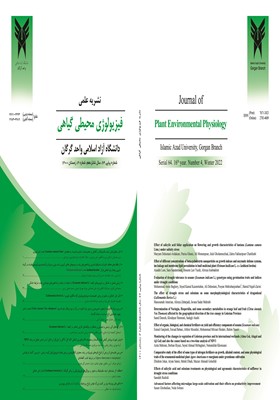-
-
List of Articles
-
Open Access Article
1 - Effect of salicylic acid foliar application on flowering and growth characteristics of lantana (Lantana camara Linn.) under salinity stress
Maryam Dehestani-Ardakani Parisa Ghatei Ali Momenpour Jalal Gholamnezhad Zahra Fakharipour -
Open Access Article
2 - Effect of different concentrations of beta-cyclodextrin nanoparticles on growth indexes and enzymatic defense systems, Ion leakage and amount of membrane lipid peroxidation in basil medicinal plant (Ocimum basilicum L. c.v. keshkeni luvelou)
azadeh loni Sara Saadatmand Hossein Lari Yazdi Alireza Iranbakhsh -
Open Access Article
3 - Evaluation of drought tolerance in sesame (Sesamum indicum L.) genotypes using germination traits and indices under drought conditions
Mohammad Amin Baghery Seyed Kamal Kazemitabar Ali Dehestani Pooyan Mehrabanjoubani Hamid Najafi Zarini -
Open Access Article
4 - The effect of drought stress and selenium on some morphophysiological characteristics of Dragons head (Lallemantia iberica L.)
Masoomeh Amerian Alireza zebarjadi javaneh alsadat mehrabi -
Open Access Article
5 - Determination Of Secondary Materials In Leaves And Orange Fruit (Thompson) In Four Geographical Directions Crown Of The Tree In Golestan Province
Saeed Danesh Khodayar Hemmati Sadegh Atashi -
Open Access Article
6 - Effect of organic, biological and chemical fertilizers on yield and efficiency elements of sesame
farzad babaei Esmael Ganghene Afshin Mozafari Mohammad Mirzaei Heidari Rahim Naseri -
Open Access Article
7 - Monitoring of vegetation changes in Golestan province And a collection of international wetlands (Alma Gol, Alagol and Aji Gol) And the reasons are based on a two-time analysis of NDVI
Azita Mehrani Borhan Riazi Seyed Ahmad Mirbagheri Nematollah Khorasani -
Open Access Article
8 - Comparative study of the effect of some types of nitrogen fertilizers on growth, alkaloid content and some physiological traits of the ornamental-medicinal plant Agave Americana cv marginata under greenhouse cultivation
Ebrahim Jokar Aryan Sateei Mehdi Ebadi Mazeyar Ahmadi Golsefidi -
Open Access Article
9 - The study Effect of teratments salicylic acid and selenium on physiological and agronomic characteristics of safflower in drought stress conditions
saedeh rashidy -
Open Access Article
10 - Screening different cold-resistant sugarcane (Saccharum ssp. L) genotypes using morphological and biochemical indices
mahmoud fouladvand asa ebrahimi mehdi rahaei vahid Shariati joni
-
The rights to this website are owned by the Raimag Press Management System.
Copyright © 2021-2025







